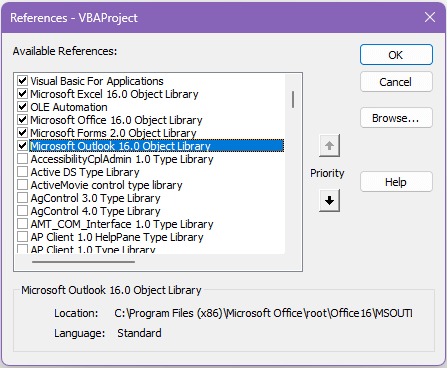Last updated: 14th August 2025
Microsoft Outlook remains one of the most trusted and secure platforms for managing emails, contacts, and calendars. Whether you're working from home or in the office. Its robust features make it ideal for handling sensitive communication and streamlining productivity.In this step-by-step guide, you'll learn how to send emails directly from Excel using VBA and Outlook. This automation technique is perfect for sending reports, alerts, or personalized messages without manually opening Outlook each time. Whether you're a beginner or an experienced Excel user, this tutorial will walk you through everything you need to know to get started.
🚀 While Microsoft Outlook allows you to send and receive emails manually, you can automate the entire process using Excel VBA macros. This powerful technique lets you generate and send emails directly from your spreadsheet—saving time and reducing errors.
Get Access to Microsoft Outlook in Excel using VBA
There are two ways you can access Outlook properties and methods using VBA in Excel.
1) You can add a reference of Outlook object in your VBA project (This is called EarlyBinding.)
Follow these steps to add a reference of the Outlook object in your VBA project
In the top menu find Tools and choose References….
In the References dialog box, find Microsoft Outlook 16.0 Object Library, click the Check-box and press OK.

Note: If you are using Office 2007, add Microsoft Outlook 12.0 Object library.
2) By creating an instance of Outlook using CreateObject() method. (This is called LateBinding.)
To get access to Outlook methods and properties, you'll have to first create an instance of Outlook in VBA. Next, initialize Outlook using CreateObject().
Dim objOutlook as Object
Set objOutlook = CreateObject("Outlook.Application")
I am using the 2nd method in my example.
Remember: You must first configure Microsoft Office Outlook in your computer. Else, the code example that I am going to show you here will not produce the desired result.
Send email from Excel
Copy the macro in the Module and click the "Run" button or press F5.
Option Explicit
Private Sub send_email()
' Use this code if you have added a Reference of Outlook in your VBA project.
' Dim objOutlook As Outlook.Application
' Set objOutlook = Outlook.Application
'
' Dim objEmail As Outlook.MailItem
' Set objEmail = objOutlook.CreateItem(olMailItem)
On Error GoTo ErrorHandler
Dim objOutlook As Object ' Set outlook application object.
Set objOutlook = CreateObject("Outlook.Application")
' Create email object.
Dim objEmail As Object
Set objEmail = objOutlook.CreateItem(0) ' 0 = olMailItem
With objEmail
.To = "xyz@email.com" ' add a real email address.
.Subject = "This is a test message from Arun Banik"
.Body = "Hi there"
.Send ' Send the message.
End With
Cleanup:
' Release objects.
Set objEmail = Nothing
Set objOutlook = Nothing
Exit Sub
ErrorHandler:
MsgBox "Error occurred: " & Err.Description, vbCritical
Resume Cleanup
End Sub
Once the macro runs successfully, Outlook will automatically send an email with the specified subject line and a simple message body that says "Hi there".
Object Initialization Explained
To automate email sending from Excel using VBA, I’ve created two key objects: objOutlook and objEmail.
1) objOutlook – Outlook Application Object
• Initialized using CreateObject("Outlook.Application").
• This object gives access to Outlook’s core functionality.
• Once created, it allows you to generate new email items using the CreateItem() method.
2) objEmail – Mail Item Object
• Created via objOutlook.CreateItem(0) where 0 represents a standard mail item (olMailItem).
• This object lets you set email-specific properties such as:
.To – recipient address
.Subject – email subject line
.Body – message content
Using .Display property to display message before sending email
Another useful feature is the ability to preview your email in Outlook before it's sent. By replacing the .Send method with .Display, you can open the email window and review details like the subject, body, recipients, and attachments. This gives you a chance to make final edits or confirmations before hitting send.
With objEmail
.To = "xyz@email.com"
.Subject = "This is a test message from Arun Banik"
.Body = "Hi there"
' .Send
.Display ' Opens the email in Outlook for review.
End WithAdd Attachments, CC and BCC in Excel
Similarly, you can test with other important properties such, CC, BCC, Attachments etc.
attachmentPath = "e:\report.doc" ' Update path as needed. With objEmail .To = "xyz@email.com" .CC = "arun@mail.com" .BCC = "arun@hotmail.com" .Subject = "This is a test message from Arun" .Body = "Hi there" ' Add attachment if file exists. If Dir(attachmentPath) <> "" Then .Attachments.Add attachmentPath Else MsgBox "Attachment not found: " & attachmentPath, vbExclamation End If� .Send End With
You've just unlocked a powerful productivity hack, automating emails directly from Excel using VBA and Outlook. Whether you're sending reports, reminders, or personalized messages, this technique can save you hours of manual work and reduce the chance of errors.
We covered:
1) How to initialize Outlook and create email objects
2) Adding recipients, subject lines, and message bodies
3) Previewing emails before sending
4) Including CC, BCC, and file attachments
But this is just the beginning. VBA gives you the flexibility to customize emails based on Excel data, schedule messages, and even trigger alerts based on conditions. So go ahead, experiment with other properties, loop through rows, and build macros that make your workflow smarter.
